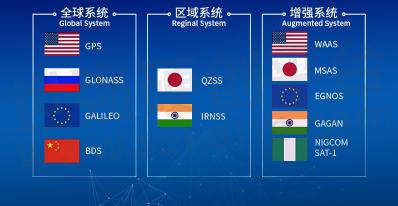The Introduction of Global Navigation Satellite System-GNSS

Global Navigation Satellite System (GNSS), also known as global satellite navigation system, is space-based radio navigation that can provide users with all-weather 3-dimensional coordinates, speed, and time information at any point on the earth’s surface or in near-earth space. GPS. It consists of one or more constellations of satellites and their augmentation systems needed to support a particular mission.
The world’s four largest satellite navigation system suppliers announced by the International Committee on Global Navigation Satellite Systems, including China’s Beidou Satellite Navigation System (BDS), the United States Global Positioning System (GPS), Russia’s GLONASS Satellite Navigation System (GLONASS) and The European Union’s Galileo satellite navigation system (GALILEO). Among them, GPS is the first global system established and used for navigation and positioning in the world, and GLONASS has become the second-largest satellite navigation system in the world after a rapid recovery. The satellite navigation system is in the experimental stage; BDS is a global satellite navigation system independently built and operated by China, providing all-weather, all-time, high-precision positioning, navigation, and timing services for global users.
Name: Global Navigation Satellite System
Systems: GPS、BDS、GLONASS and GALILEO
Function: Provide users with all-weather 3D coordinates, speed, and time information
Abbr.: GNSS
Application: Navigation, positioning, measurement, agriculture, rescue, surveillance and management, military, etc.
The global satellite navigation system is used in military affairs, resources, and environment, disaster prevention and mitigation, surveying and mapping, power telecommunications, urban management, engineering construction, mechanical control, transportation, agriculture, forestry, fishery and animal husbandry, archaeology, life, Internet of Things, location services There are applications.
Four Major Systems:
BeiDou System (BDS)
The BDS is composed of three parts: the space segment, the ground segment, and the user segment: the space segment consists of a number of geostationary orbit satellites, inclined geosynchronous orbit satellites, and medium-circular earth orbit satellites to form a mixed navigation constellation; the ground segment includes the main control station, Several ground stations such as time synchronization/injection stations and monitoring stations; the user segment includes basic products such as BDS chips, modules, and antennas which are compatible with other satellite navigation systems, as well as terminal products, applications, and service systems.
GPS System
GPS has been developed so far and has entered the stage of modernization completion. Modernization is a systematic work, which includes: the space satellite segment, the ground operation control segment, the new operation control system (operational control system, OCX), and the modernization of the user equipment segment. The core mission is to increase the number of L5 frequency points and Civilian Signals and its Changing-Standards, to achieve interoperability with other GNSS signals. The last GPSIIIF is expected to be launched in 2034, announcing the end of the GPS modernization process.
GLONASS System
The GLONASS constellation consists of 24 satellites on 3 orbital planes. Its legacy signals use frequency division multiple access (FDMA), rather than the code division multiple access (CDMA) used by other GNSSs. Like the traditional GPS signal, the GLONASS signal includes 2 pseudorandom noise codes (PRN) ranging codes: standard accuracy (ST) code and high precision (Visokaya Tochnost or VT) code, modulated onto the L1 and L2 carriers. The GLONASS ST code has also been transmitted on the L2 frequency of the GLONASS-M satellite. The transmitted signal is a right-hand circularly polarized wave like a GPS signal. GLONASS-K1 transmits CDMA signals on the new L3 frequency (1202.025 MHz), and GLONASS-K2 will also provide CDMA signals on L1 and L2 frequencies, enabling compatibility and interoperability with other GNSS. The signal-in-space user range errors (SISRE) of the GLONASS-K1 star is about 1 m, and that of the GLONASS-K2 star is 0.3 m.
Galileo System
Galileo is the European global navigation satellite system (E-GNSS).
Galileo also consists of a space segment, an operation and control segment, and a user segment. The constellation has 24 satellites placed in three medium-circle Earth orbital planes. The main frequency bands of Galileo signal work are E1, E5, and E6. They each transmit an independent signal centered at frequencies: 1575.42, 1191.795, and 1278.75 MHz. Among them, E5 is divided into two sub-signals, E5a, and E5b. In order to achieve compatible interoperability with GPS, the center frequencies of Galileo’s E1 and E5a signals coincide with GPS’s L1 and L5. For the same compatibility and interoperability purposes, Galileo’s E5b coincides with the GLONASS’s G3 signal center frequency.
Galileo provides 5 services, namely:
① Open service (OS), similar to the SPS of GPS, is provided free of charge;
② Safety of Life service (SoLS);
③ Commercial service (CS);
④ Public Regulated service (PRS);
⑤ Search and Rescue service (SAR)
Other Systems
In addition to the above four major global systems, it also includes regional systems and augmented systems. The regional systems include Japan’s QZSS and India’s IRNSS, and the augmented systems include the United States WASS, Japan’s MSAS, the European Union’s EGNOS, India’s GAGAN, and Nigeria’s NIG-COMSAT-1, etc.

- +1 Like
- Add to Favorites
Recommend
- Installation of UIY Surface Mounting Isolator/Circulator
- UIY Released New 180° 3dB UIY2T2HC4040A, Operating Over 6-18GHz Ultrawide Band, Insertion Loss Less Than 1.5dB
- UIY INC. Exhibits at 2024 IMS Washington D.C. 18th~21th June
- 5 Clues Help Understanding the DBS Band
- Things You Need to Know About Combiner and Duplexer
- Frequency Bands Suitable for Satellite Communications
- Microstrip Isolator/Circulator Mounting Instruction Manual
- Installation Instruction of Drop In Isolator & Circulator
This document is provided by Sekorm Platform for VIP exclusive service. The copyright is owned by Sekorm. Without authorization, any medias, websites or individual are not allowed to reprint. When authorizing the reprint, the link of www.sekorm.com must be indicated.
























































































































































































































































































































































































































































































































































































































































































































































































































































































